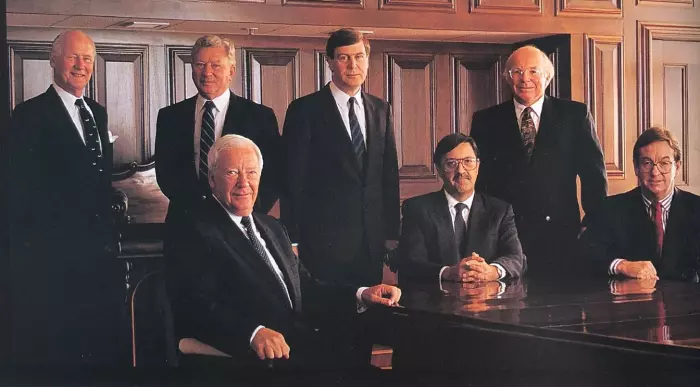The second half of 1990 was another traumatic period for the Bank of New Zealand (BNZ), with the Capital Markets/Fay, Richwhite merger approved on Aug 29, a general election held on Oct 27, and a further BNZ restructuring announced on Nov 5.
After the general election, the BNZ’s problems were in the hands of the new National government, which now had 67 MPs, compared with 40 in the previous Parliament, while Labour’s representation plunged from 57 seats to just 29.
Ironically, the only other MP was NewLabour’s Jim Anderton, who had resigned from the Labour Party, partly because of its asset-sales strategy.
Lead-up to second restructuring
The BNZ had a two-fold approach throughout the latter part of 1990. On the one hand it was presenting a positive message to investors and the public, but behind closed doors it was grappling with continuing bad-loan problems, particularly across the Tasman, and the need to raise more equity.
On May 24, 1990, the bank announced a net profit of $121.1 million for the March 1990 year, compared with a loss of $626.6m for the previous year.
Chairman Syd Pasley made some remarkably upbeat comments including: “Twelve months ago, the bank faced an unparalleled challenge. This was met with prudent and conservative management, which resulted in the profit announcement today.”
The profit announcement went on to reveal that the bank’s tier-one capital stood at 6.44% – with the total capital ratio increasing to 9% – and that “these comfortably exceed international capital adequacy guidelines as well as those of the Reserve Bank of NZ”.
But Capital Markets, which owned 30.5% of the BNZ at the time, was less upbeat, because any further loan provisioning would have had a major impact on its fragile balance sheet.
On April 23, a month before the BNZ profit release, it announced a proposal to acquire 100% of Fay, Richwhite & Co for $225m. As the purchase price included $110m of cash, the listed company would have much higher borrowings and a weaker balance sheet and would be in a far worse position to participate in any further BNZ capital raising.
Housing Corporation
Capital Markets needed an innovative solution and Fay, Richwhite initiated a proposal whereby the crown would sell the Housing Corporation’s mortgage portfolio to the BNZ in return for the issue of $600m worth of BNZ preference shares to the government. This would inject new capital into the struggling bank.
On July 17, BNZ managing director Lindsay Pyne and a Fay, Richwhite representative met Treasury officials to present this proposal.
On the following day, Pasley gave another upbeat presentation at the BNZ annual meeting. He said the bank had refocused on its core businesses and “this has strengthened the quality of the bank’s balance sheet”.
In early Aug, finance minister David Caygill rejected the Housing Corporation proposal and on Aug 15, he met with Pasley, Pyne and Robin Congreve, a BNZ director who was also on the board of Capital Markets.
An aide-memoire prepared for the meeting and later released under the Official Information Act stated that the Housing Corporation “transaction would benefit minority shareholders (including Capital Markets) at the expense of the crown” and “the government would expect the terms for involvement in any capital-raising exercise to be in line with those applying to all shareholders”.
The rejection of the Housing Corporation proposal was a major disappointment to the BNZ board, particularly the directors appointed by Capital Markets. It followed Caygill’s rejection of a BNZ proposal to buy the Rural Bank in 1989.
Capital Markets argued that the crown had a moral obligation to resolve the BNZ’s problems because most of the non-performing loans had been made while the bank was 100% owned by the government, and Capital Markets hadn’t been fully informed of the bank’s true position when it invested in mid-1989.
Sept to early Nov, 1990
In early Sept, shortly after Capital Markets’ shareholders approved the purchase of Fay, Richwhite & Co, another major conflict broke out behind closed doors.
Credit Suisse First Boston, the Treasury’s advisers, recommended a cash issue to all BNZ shareholders, with the crown agreeing to underwrite the offer.
However, the bank’s board rejected this cash-issue proposal as it had a bias towards a new Fay, Richwhite plan, a “bad bank” structure, which would remove the requirement for further bad-loan write-offs in the BNZ’s accounts.
The BNZ board consisted of Pasley (chair), Congreve (deputy chair), Pyne (managing director), Len Bayliss, Michael Fay, Geoff Ricketts and David Sadler.
Congreve, Fay and Ricketts were also directors of the newly merged Capital Markets/Fay, Richwhite & Co listed company.
On Sept 17, the BNZ appointed Booz Allen Hamilton to undertake another independent assessment of the bank’s loan portfolio, particularly in Australia.
Booz Allen’s draft report, which was presented to the BNZ board on Sept 30, confirmed that a further $600m provisioning would be needed in Australia and an additional $200m in NZ.
The Booz Allen figures meant that 30% of the BNZ’s total Australian loan portfolio was being provisioned, an amazingly high figure that illustrated the dreadful performance of the bank’s Australian operations.
The BNZ board met on Oct 18 to consider a Buttle Wilson assessment of Fay, Richwhite’s “bad bank” proposal and other aspects of the bank’s recapitalisation.
BNZ directors endorsed the Fay, Richwhite proposal and this was presented to Caygill the following day. The proposal – and Buttle Wilson’s assessment – was reviewed by the Treasury, which concluded that it didn’t give full value to minority shareholders and was unusually generous to Fay, Richwhite.
Nevertheless, the Treasury was in broad agreement with the Fay, Richwhite proposal, even though it was very different from the earlier recommendation from its own advisers, Credit Suisse First Boston.
The Treasury noted that a few minor points needed to be finalised and asked Caygill whether he wished to meet the BNZ directors and Fay, Richwhite over the Oct 20-22 Labour Weekend with the objective of presenting a final proposal to the cabinet on Tuesday, Oct 23.
Caygill declined, and the final BNZ proposal wasn’t on the Oct 23 cabinet agenda. National won the election the following Saturday and the BNZ was now a National government’s problem.
Prime minister Jim Bolger
Prime minister-elect Jim Bolger was briefed on the BNZ situation on Sunday, Oct 28, the day after the election, and two days later, he received a Treasury paper with the proposed timetable for BNZ’s recapitalisation.
Senior National MPs named to form the new cabinet met on Friday, Nov 2, to consider the general principles of what was now known as the “Adbro” structure, a separate loan-recovery company.
The prospective new ministers met again on Monday, Nov 5, to consider the final recommendations of the Treasury paper, noting that this “will be the first major policy statement of this government”.
Nov 5, 1990, announcement
At 4pm on Monday, Nov 5, 1990, the media machines of the BNZ, prime minister Bolger, finance minister Ruth Richardson, Fay, Richwhite & Co and the Reserve Bank went into massive overdrive.
The BNZ’s stock exchange release was optimistically headed “Bank of New Zealand announces half-year profit and balance sheet restructuring”. The bank was only able to announce a profit because Booz Allen’s additional $800m provisioning had been effectively shifted into Adbro Investments Ltd.
The proposed Adbro balance sheet was as follows:
| Adbro Investments: balance sheet | |
|---|---|
Assets | $m |
BNZ loans | 2831.8 |
| 2831.8 |
Liabilities |
|
NZ government | 420.4 |
Fay, Richwhite | 50.0 |
Owed to BNZ | 2361.4 |
| 2,831.8 |
- Adbro was a $100 company co-owned by the crown (81%) and Fay, Richwhite (19%).
- The BNZ transferred $2831.8m of loans to Adbro, $2278.8m of which were non-performing. However, the bank believed that at least $1078.4m of the $2831.8m loan portfolio would be recovered.
- The crown invested $420.4m in Adbro and in return BNZ gave up estimated tax losses of $578.5m associated with the Adbro portfolio. Thus, the crown invested $420.4m and in return the BNZ would pay additional tax of $578.5m in the future.
- Fay, Richwhite provided funding of $50m, with the remaining $2361.4m provided by the BNZ as a limited-recourse loan.
Recoveries from the Adbro portfolio would be allocated as follows:
• The first $1.1 billion would be used to reduce the limited-recourse loan from the BNZ.
• Of the next $150m, one-third would go to Fay, Richwhite, one-third to repay the limited-recourse loan and one-third to the crown.
• Two-thirds of the remaining recoveries would go to the BNZ and one-third to the crown.
The BNZ effectively provided and underwrote Fay, Richwhite’s $50m investment in Adbro in the event that the recovery formula was insufficient to repay the $50m.
The BNZ’s Nov 5 release noted that the crown would obtain a return of 15% a year on its Adbro investment and Fay, Richwhite 14%.
Adbro was promoted as a “bad bank” but it was little more than a money-go-round. From a legal point of view, the BNZ remained the owner of the Adbro loan portfolio and continued to manage the relationship with customers.
Under stock exchange rules, the Adbro structure required shareholder approval because of the transfer of at least $578.5m of tax losses to the crown as well as the BNZ’s $2361.4m limited-recourse loan to Adbro, which was owned by the crown and Fay, Richwhite.
True to form, the NZX granted a waiver from this shareholder-approval requirement.
Capital raising
The BNZ also announced two capital raisings on Nov 5:
• 200 million new ordinary shares would be issued to the crown at 70 cents each, a total of $140m.
• 131 million convertible preference shares would be issued to Fay, Richwhite at 84 cents each, a total of $110m.
An underwriting fee of 2 cents per share – a total of $6.6m – would be paid to the crown and Fay, Richwhite by the BNZ in relation to these capital raisings.
In addition, the crown agreed to purchase 85.7 million BNZ shares from Fay, Richwhite at 70 cents each, a total of $60m. This effectively reduced Fay, Richwhite’s net new capital contribution to $50m.
The convertible preference shares issued to Fay, Richwhite were more attractive than ordinary shares because they had an effective 11% a year after-tax yield while the ordinary shares had a dividend yield of only 2.8%.
The BNZ and the crown didn’t offer the same attractive deals to other BNZ shareholders.
Fay, Richwhite’s preference shares converted to BNZ ordinary shares on a one-for-one basis but the conversion rate was 1.25 ordinary shares for every one preference shares if BNZ received a takeover bid within one year and a 1.2-for-one conversion rate if a bid were received in year two.
Fay, Richwhite clearly had a big incentive to encourage a takeover offer for BNZ.
Market reactions
It was difficult to see any advantages to the BNZ from the Adbro money-go-round as the bad loans stayed with the bank, it still carried all the risks, and the crown received a very high return on its Adbro investment.
In addition, the BNZ paid all Adbro’s fees, costs and expenses “without limitation”, even though Adbro was owned by the crown and Fay, Richwhite.
BNZ directors argued that its customers, lenders, shareholders and staff, as well as the credit agencies, would react negatively to a second large loss. This was incredibly naive, as financial markets respond much more negatively to shonky accounting, unequal treatment of shareholders, and companies that continuously issue overly optimistic statements.
The market reaction to the Nov 5 announcement was devastating. The BNZ’s share price plunged from 72 cents just before the announcement to 53 cents on Nov 6. The bank’s share price was 46 cents at the end of 1990.
Media reports were highly critical of the Adbro structure, including a particularly negative feature by the Australian Broadcasting Corporation’s Four Corners programme.
The Adbro structure also fanned the flames for MP Winston Peters’ attack on the BNZ and Fay, Richwhite, which ultimately led to the Winebox Inquiry.
But there was still one more twist to come in the long-running BNZ saga.
Looking back: David Lange, Roger Douglas, Ron Brierley and the BNZ
Looking back: BNZ Part 2: Rob Campbell, Frank Pearson and the bank
Looking back: BNZ Part 3: Lindsay Pyne, Michael Fay and the bank
Looking back: BNZ Part 4: Capital Markets, Fay, Richwhite and the bank
Looking back: BNZ Part 5: The Winebox company and the bank
Disclosure of interests: Brian Gaynor is a non-executive director of Content Limited, the publisher of BusinessDesk, and of Milford Asset Management.
[email protected]














